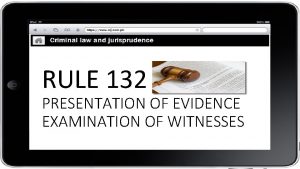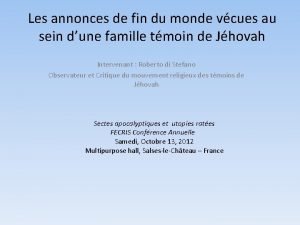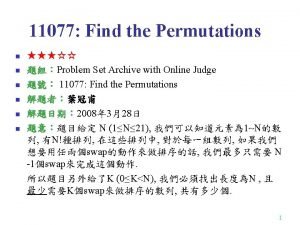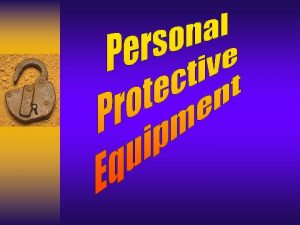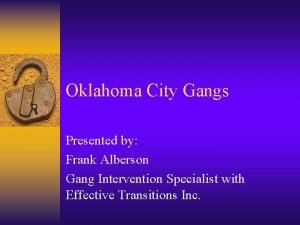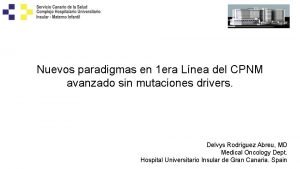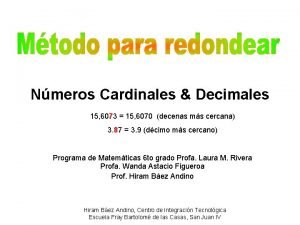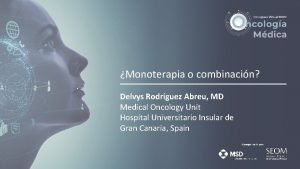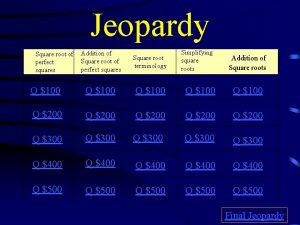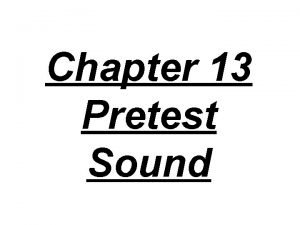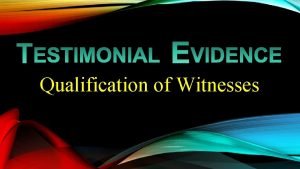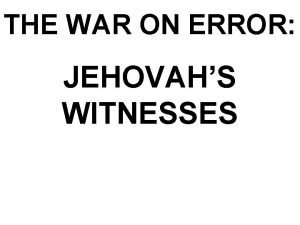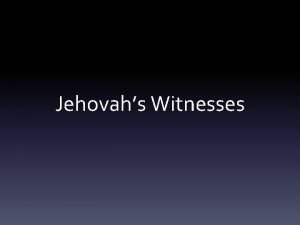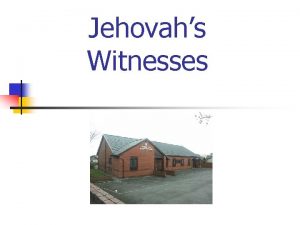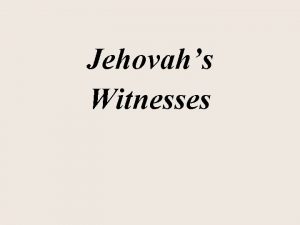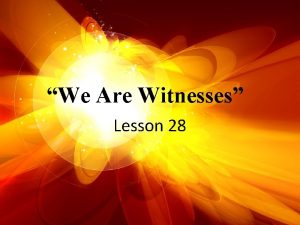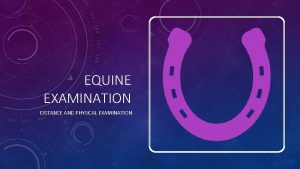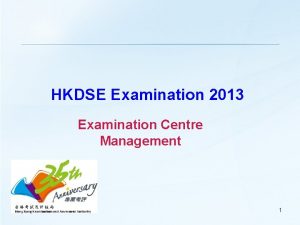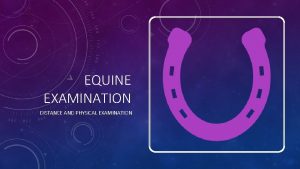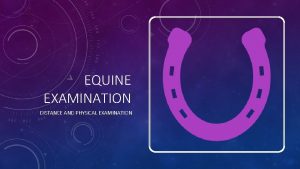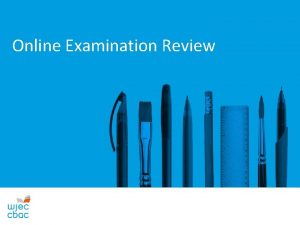RULE 132 PRESENTATION OF EVIDENCE EXAMINATION OF WITNESSES




















- Slides: 20

RULE 132 PRESENTATION OF EVIDENCE EXAMINATION OF WITNESSES



Section 1. Examination to be Done in Open Court Rules: 1. ORAL EVIDENCE GIVEN: The must: usual of presenting It oral 2. Questions a witness 3. HOW Effect ofpropounded Failure toto Take Oath orway Affirmation: is testimony isheld to call thewhere witness to the stand without ask him questions. The generally that a witness testifies having sworn, a. NOT BE relevant; g. call forofself-incriminating testimony; testimony witnesses is elicited by interrogation or the propounding the judgment will be set aside if the error is not discovered until after of questions. b. NOT beleading; indefinite or uncertain; h. NOT be judgment. (Herrera). Ø Purpose: to enable the court to judge the credibility of the c. NOT bemisleading; argumentative; i. NOT be Ø However, the right to have a witness sworn may be waived if the other witness by: party fails to degrade object toreputation theof taking the testimony of a witness without d. NOT call for conclusion law; ofofwitness; j. NOT tend to 1) the witness’ way of testifying, the administration of an oath e. NOT call for opinion or 71, hearsay evidence; 2) their intelligence’ and k. be repetitious; Ø NOT Under Section 1, Rule the refusal to be sworn or to answer as a 3) their f. NOT callappearance fora illegal answer; witness constitutes direct contempt of court. . l. NOT call for narration.

Section 3. Rights and Obligations of a witness CLASSIFICATION OF 1. Usepurposes immunity-ofonly prohibits theagainst use of selfincrimination witness’ IMMUNITYSTATUTES: Ø For evidence, right compelled its fruit in any manner in refers only to testimony testimonialand compulsion. connection with the criminal prosecution of the witness. Ø Right against self-incrimination is grated from only to individuals, It does not render a witness immune prosecution despite invocation of right against hence, a corporation CANNOT invoke selfincrimination. tjhat privilege as the testimony can comegrants only from a corporate or 2. question Transactional immunity to theofficer witness from prosecution an offense distinct to whichfrom his compelled employee who has for a personality that of a testimony relates. corporation.

Section 3. Rights and Obligations of a witness Rules: 1. THE BILL OF RIGHTS OF A WITNESS: Note: Ø a. To be protected from irrelevant, improper, or insulting questions, and from harsh or insulting demeanor; the basis of a civil liability. b. Not to be detained longer than the interests of justice require; Ø exception The under IMMUNITY refers letter to d. be examined STATUTES wherein c. Not to except only as to matters pertinent to the issue; the is granted fromtocriminal prosecution offenses d. witness Not to give an answerimmunity which will tend subject him to a penalty for an offense admitted his testimony, unlessinotherwise provided bye. g. , law; under Section 8, R. A. 1379, the law providing forgive theanforfeiture of unlawfully required and under e. Not to answer which will tend to degrade his property; reputation, unless it be to. P. D. the fact at issue or a fact from which the fact in issue would be presumed. But a 749, invery prosecutions fortobribery and graft. witness must answer to the fact of his previous final conviction for an offense.

WITNESS PROTECTION, SECURITY, AND BENEFIT ACT (RA 6981) Sec. 10. State witness. Definition: v State Witness- person who has participated in the commission of witness state program entitle Admission such the into and desires to be a witness for the state shall be admitted into Ø ashall crime to program immunity from criminal prosecution forinthe offenses in which execute a sworn statement describing detail manner the whenever the following circumstances arethe present: his testimony will be given and(Sec. used. 11) (Sec. 12) and his participation therein. 4. be his substantially its material 1. his thetestimony offense in can which testimony corroborated will be used ison a grave felony points; as defined ureapplication RPC its equivalent under denied, sworn statement his said is and If under 5. Ø he does notorappear to be the mostspecial guilty; laws; and shall be prosecuted for contempt if he testifies falsely or other testimony given in support of said application shall NOT 2. absolute necessity for his testimony; 6. evasively, he has nothe at shall any time been convicted of any crime involving moral be removed and shall be subject to contempt admissible in evidence. turpitude. 3. be there is no direct evidence available for the prosecution of the offense or criminal prosecution. (Sec. 13) committed;

Section 4. Order in the examination of an individual witness. Order: Rules: Ø 1. Limitations Direct Examination DIRECT on EXAMINATION – the examination-in- 1. direct examination; 1) Questions calling for conclusions or opinions, except when opinion chief of a witness. testimony is permissible. 2. cross-examination; GENERAL RULE: 2)Exceptions: Repetitive questions. 3. redirect 3)Witness Compound or form those(Thresher which more 68 than one is her ownexamination; counsel. vs. Bank, Conn. Testimony inquestions narrative is NOTembraces allowed. to be answered. 201, inquiry 36 Atl. 38) When allowed by the trial court. (People re-cross examination. 4)vs. 4. Erroneous assumption in issue has been proved Davis, 6 Cal. App. that 229, a material 91 Pac. fact 810) or that the witness has given certain testimony.


Section 4. Order in the examination of an individual witness. Rules: 2. CROSS-EXAMINATION an examination to rebut matters stated in the ØScope or Limits of–Cross. Examination: direct examination and any inference or deductions which may be 1) English Rule — a—witness is crossexamination called to testify to to a facts drawn therefrom. 2) American Rule restricts particular fact, he becomes a witness for all purposes and circumstances which are connected with the Ø PURPOSES: and may be fully cross-examined upon allinmatters that have been stated the direct 1)matters to discredit the witness; material to the issue, the examination not being of the witness. 2)examination to discredit testimony of the witness; confined to the matters inquired about in the direct 3) to clarify certain matters; Note: Bothadmissions rules arefrom followed in the Philippines. examination. 4) to elicit a witness.

LEA Section 4. Order in the examination of an individual witness. Rules: v DOCTRINE OF INCOMPLETE TETIMONYwitness case is bound the testimony of said only if in sothe declared by thebycourt upon adequate EXCEPTION: GENERAL RULE: witness, EXCEPT: showing of: Where prosecution witness was extensively When cross-examination cannot bedone or cross 1) adverse party; 1) his adverse interest; examined points and to thereafter completedon duethe to material causes attributable the partyfailed who 2) hostile witness; to appear and cannot be produced athe warrant offered the witness, theor incomplete testimony is 2) unjustified reluctance; hi havingdespite misled party 3) witness; for hisunwilling arrest. rendered incompetent stricken out of the into calling him to theshould witnessbestand. record. 4) witness required by law to be presented.

Section 4. Order in the examination of an individual witness. Rules: 4. 3. RE-CROSS-EXAMINATION REDIRECT EXAMINATION – aanreexamination by of the adverse witness byparty the party of calling a witness him after he has re-direct been examination. cross-examined to explain or supplement his answers given during cross-examination. a. The adverse party may re-crossexamine the b. complete the of ainwitness a. Purpose: Questions. Toon matters notanswer dealt with during theofcrosswitness matters stated his or re-direct adding a new matter which hassuch been omitted, or ofin its examination may allowed by other the court examination and be also on matters in correcting discretion. a possible misinterpretation of testimony. the discretion of the court. (People vs. de Guzman, GRN 117217, Dec. 2, 1996)

Section 9. RECALLING WITNESS Rules: 1. GENERAL RULE: Ø MISLEADING QUESTION––one which assumes true Ø LEADING QUESTION suggestsasto thea fact not yet testified towhich by thethe witness, or contrary to desires. that witness the answer examining party A witness cannot be recalled after the which he has previously stated. Exceptions: examination by both parties has been concluded. General Rule: Exceptions: General Rule: e) c) Of When witness there who isis difficulty is an adverse in getting party direct or an officer, and On across-examination; 2. a) Exception: Leading question not allowed. a) Adirector, when waived; d) Of an unwilling orfrom hostile witness; or misleading question is not allowed. intelligible or answers managing agent a witness of who a public is ignorant, or private or b) When On preliminary matters; allowed theorcourt in association the mind, interest a child of tender or of by years, a partnership isquestions of or feeble which aof deafis an b) corporation asking hypothetical to or an expert justice. adverse mute; party. witness.

Section 9. RECALLING WITNESS Rules: 4. 3. EXAMINATION PROCEDURE FOR OFIMPEACHING WITNESSES UNDER WITNESS THEBY RULES EVIDENCE ON OF ELECTRONIC PRIOR INCONSISTENT EVIDENCE STATEMENTS (LAYING THE PREDICATE) b. Cross-Examination of Deponent: The affiant shall be made a. Method of Proof: Affidavit Evidence: All matters relating a. The statement must be related to him with the circumstances to affirm the contents of the affidavit in open court and to the admissibility and evidentiary weight of c. he must be asked whether he made such statements, an of the and places may and persons present; by an affidavit may betimes cross-examined. electronic document be established and if so, allowed to EXPLAIN them b. Electronic If the statement be in. After writing they must be of shown to the stating facts of direct personal knowledge the parties affiant c. Testimony: summarily hearing the witness any is put to him the concerning them; or basedbefore on authentic records. pursuant above, thequestion court may authorize presentation and of testimonial evidence by electronic means.


Section 9. RECALLING WITNESS Rules: b. Methods Unwillingofor Hostile Witness – one declared by. To the a. Impeaching 5. IMPEACHMENT OFa Witness WITNESSES: court as such upon adequate showing: 2) By a Party to His Own Witness: a. Party witness means to discredit the 1) “impeach” the Adverse 1)Other of contradictory his. Modes adverse interest; General Rule: of. A Impeachment: party cannot impeach athe credibility By evidence vd)a) witness’ testimony. Impeaching witness isofa his own witness. evidence of particular wrongful acts unless c) Exception toreputation the Exception: The adverse witness, or is his b) By general forof truth, honesty or there integrity isa 2) unjustified reluctance to testify; or 3) By proving action or conduct the witness inconsistent with fundamental right on cross-examination. 1) By involving him during cross-examination showing of previous conviction final judgment. Existence b) Exception: When the witness he produced or him called isthe an testimony, e. g. , failure towitness make anby outcry in rape unwilling or hostile cannot be impeached by bad 3)2) his having misled the party into calling to By sowing the impossibility or improbability of his of pending information may not be feeling shown tocourt impeach him. adverse witness, or character. one by the as adverse 4)c) By showing bias, interest or declared hostile against the evidence of his bad By previous inconsistent statements testimony witness stand. party (People vs. Nanas, GRN 137299, Aug. 21, 2001) unwilling or a hostile witness.

Section 9. RECALLING WITNESS Rules: 6. b. Nature 7. IMPEACHING of the A WITNESS Rule “Falsus BY EVIDENCE in Uno, OF Falsus PRIOR in However the rule does not really lay down a categorical test of INCONSISTENT Omnibus” credibility. (People. STATEMENTS: vs. Letigo, GRN 112968, Feb. 13, 1997). It is not positive rule ofground law or of universal application. It should not be the maxim falsus in omnibus, there 1. a. 2. AUnder witness a may be impeached isin uno, thus upon that crosshe a. a. Unless Laying Down the Predicate –bylaid a evidence process of crossapplied to portions of thea witness testimonywho corroborated by other is a presumption that has willfully given has examination, made at evidence different of time contradictory statements examining a witness upon the point of prior evidence, particularly were the false portions could be innocent false testimony in one detail hastestimony. also on testified falselydoain mistakes. Inconsistencies contradictions details inconsistent statements with are not hisandpresent admissible tominor impeach contradictory statements. other respects and mayofbe considered unworthy of belief not impair the credibility witnesses as they are but natural. witness. as to the rest of his testimony. (People vs. Pacapac, GRN 90623, Sept. 7, 1995)

nger Section 9. RECALLING WITNESS Rules: 8. IDENTIFICATION TESTIMONY: c. Totality of Circumstances Test – a test to resolve the b. Out-of-Court Identification of Suspects: a. Components of Identification Testimony: admissibility and reliability of out-of-court identification 1) Show-ups, where the suspect alone is brought face to face 1) Witnessing a crime, whether as a victim or bystander, v of suspects considering the following factors: with the witness for identification. involves perception of an event actually occurring; each of these three stages, for whenever people attempt to 1) The witness’ opportunity to view the criminal at the time 4) The level of certainty demonstrated by the witness at the 2) Mugretain Shots, and where photographs are shown to the witness to acquire, retrieve information accurately, they are 2) identification The witness must memorize details of the event; and of the crime; identify the suspect. limited bylength normal human fallibilities and suggestive influences. 5) The of time between the crime and the identification; and 3) The witness must be able to recall and communicate 2) The witness’ degree of attention at that time; 3) Line-ups, where a witness identifies the suspect from a (People vs. Teehankee, of Jr. , the GRN 111206 -08, Oct. 6, 1995) 6) The suggestiveness identification procedure. 3) accurately. The accuracy of any prior description givenofbyidentification. the witness; group of persons lined-up for the purpose

Section 9. RECALLING WITNESS Rules: Note: 11. 10. 9. WHEN AUTHENTICATION WITNESS MAY AND REFER PROOF TOOF DOCUMENTS: MEMORANDUM: the introduction of evidence sufficient to Ø Classification of Documents Requisites: This rule permits athat witness refresh his memory sustain awritings finding it istothe writing that the a. Public Documents b. All other are private. 1) Themade entries were written recorded byto the witness 2) He such entries at theor time the events occurred, or respecting a fact by anything written or recorded by proponent of the evidence claims it be; that 3) The Public records, keptacts, in the Philippines, ofofficial private documents written official or or records of the acts of the v 1) himself; immediately thereafter, at any other time when the himself or under his direction. This provision applies only required by law to beofficial entered therein. sovereign authority, bodies and the tribunals, and public which is necessary to establish genuineness facts were still fresh in his memory; and The writer must public, official, commercial and private documents. But when it is shown beforehand that there is need to officers, whether of the Philippines, or of a foreign country; 4) A document electronically notarized in accordance with the of aassure document. court when theare entries wereinmade, those when these types ofthat documents offered evidence, refresh thethe memory of the witness. rules promulgated by the Supreme Electronic 2) Documents acknowledged before a. Court. notary(Rules publicon except last entries the truth. they fall into either public or private documents. Evidence, A. M. No. 01 -7 -01 -SC) wills andreflected testaments; and

Section 9. RECALLING WITNESS Rules: 12. PROOF OF AUTHENTICITY 13. HANDWRITING: a. DOCUMENT Ø PRIVATE The genuineness of handwriting may be proved: 2) Private Documents that Need bemust Authenticated to 1) execution and authenticity be by: b. The By any adue comparison, made by the witness orhandwriting theproved court with a. witness who believes itnot to be the of be Admissible writings admitted or saw treated genuine byexecuted the partyor a) Byperson anyone who theasdocument such because: v v. Ancient genuineness The execution due andor document the ofthe evidence is offered, or proved to be against whom written; a) Document; Requisites: b)II. Actionable Document; An document actionable document must 1) he has seen the person write; orthe I. are By reciting the substance of document in the Without attaching the to the pleading, by deemed admitted when NOT denied under oath by identified as that which it s claimed to be. genuine to the satisfaction ofthe judge. I. 2) It. Itishas more than thirty (30) years old athis the time itought is introduced pleaded: b) By evidence of the genuineness the signature or III. It is does produced not from bear a any custody sign where of alteration it toeven or be he seen writing purporting to be upon which theof pleading and attaching to pleading a copy that reciting into the pleading the entire text the in party against whom it was pleaded. It is not evidence; witness has acted orsuspicion. been charged. v document. Handwriting experts are not mandatory. handwriting of the maker. circumstances had been genuine; of and document; or necessaryitto formally offer it in evidence.
 Rule 132
Rule 132 Jehovah's witnesses armageddon 2034
Jehovah's witnesses armageddon 2034 Addiction medicine expert witness
Addiction medicine expert witness What is a primary source
What is a primary source Primary evidence vs secondary evidence
Primary evidence vs secondary evidence Primary evidence vs secondary evidence
Primary evidence vs secondary evidence Primary evidence vs secondary evidence
Primary evidence vs secondary evidence Jobs vancouver
Jobs vancouver How can class evidence have probative value
How can class evidence have probative value Class evidence vs individual evidence
Class evidence vs individual evidence Class evidence can have probative value.
Class evidence can have probative value. Class vs individual evidence
Class vs individual evidence Define ecological fallacy
Define ecological fallacy 123 132 213 231 312 321
123 132 213 231 312 321 29 cfr 1910 regarding face head foot and hand protection
29 cfr 1910 regarding face head foot and hand protection What gangs are in oklahoma
What gangs are in oklahoma Impower 132
Impower 132 15 diezmilésimos en decimales
15 diezmilésimos en decimales Impower 132
Impower 132 Simplify square root of 289
Simplify square root of 289 What phenomenon is created by two tuning forks
What phenomenon is created by two tuning forks
